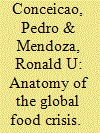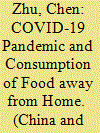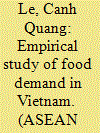| Srl | Item |
| 1 |
ID:
090209


|
|
|
|
|
| Publication |
2009.
|
| Summary/Abstract |
Dramatic food price increases affected much of the developing world in 2008. Even as food prices have begun to relax in 2009, this trend is highly uneven across countries, and in many countries local food prices remain high relative to past levels. Furthermore, the challenge of addressing the root causes of the global food crisis remains. This paper contributes to the policy discussions in this area by offering a preliminary diagnostic of the possible factors behind the global food crisis that erupted in 2008. Some are more immediate and possibly short-term in nature, such as the volatility in the commodities markets arising from short-term financial speculation. Others, however, are going to or have already started to affect countries' food security in the medium to longer term. These include rising and changing patterns of consumption in fast-growing and large developing countries like China and India, the possibly increasing trade-off between biofuels and food, and the unfolding effects of climate change. Keeping in mind the possible structural features of the global food landscape from here on, the paper outlines a framework for policy actions, both unilateral and collective, to address the food crisis and ensure future global food security.
|
|
|
|
|
|
|
|
|
|
|
|
|
|
|
|
| 2 |
ID:
182580


|
|
|
|
|
| Summary/Abstract |
This article investigates how the COVID-19 pandemic and related public health measures affected the consumption of food away from home (FAFH) among Chinese consumers. We obtained access to the complete sales records from a major restaurant chain in China, for 111 sites located in 12 cities, covering over 5.6 million high-frequency dining transactions made between 1 January 2019 and 31 December 2020. By applying a high-dimensional fixed-effects model, we found that, on average, consumers spent more and ordered more calories (as well as carbohydrates, protein, fat, and sodium) after the COVID-19 outbreak than in the pre-COVID-19 period. Our results do not support the hypothesis that COVID-19 led to healthier eating behaviors during and after the pandemic. Our results underline the importance of nutrition education and awareness programs to mitigate unhealthy eating habits generated by the pandemic and of the continued role of FAFH after the pandemic.
|
|
|
|
|
|
|
|
|
|
|
|
|
|
|
|
| 3 |
ID:
085709


|
|
|
|
|
| Summary/Abstract |
This paper uses a linear approximation of Almost Ideal Demand System (AIDS) and extended AIDS models to investigate food consumption in Vietnam using the Vietnam Living Standard Survey (VLSS) in 2004. In particular, AIDS models are estimated to calculate income and price elasticities for three different components of food categories. Our results suggest that rice food and meat/fish are normal goods, while non-rice food is luxury. Household characteristics such as age, gender, and education do not appear to affect food consumption significantly, while urban/rural location is important. These results may give empirical evidence for policy-makers to design food policy in Vietnam.
|
|
|
|
|
|
|
|
|
|
|
|
|
|
|
|